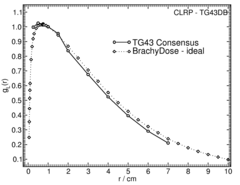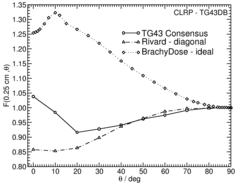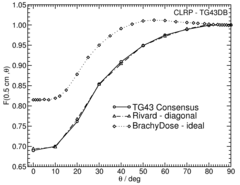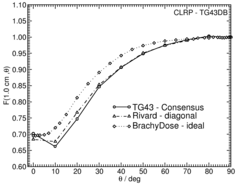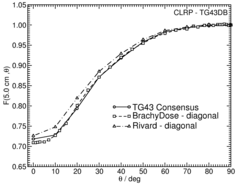

Source Description:
Dimensions and internal source configurations for the Med3631 source 1,2,3 are taken from the study by Rivard. The Med3631 125 I seed consists of polystyrene spheres (0.560 mm diameter), coated with a negligible thickness of radioactive material, with two located on each side of two 0.560 mm diameter 80% Au / 20% Cu alloy spheres. The encapsulating titanium cylinder has an outside diameter of 0.810 mm and an inner diameter of 0.710 mm. The source has an average weld thickness of 0.100 mm. The end welds are modelled using a 0.405 mm radius Ti hemisphere overlapped with a 0.355 mm radius air sphere with its center shifted by 0.0500 mm relative to the Ti sphere. Calculations are done with the internal spheres arranged in the "ideal" configuration (center of source spheres located at ± 1.807 mm and ± 1.084 mm, center of marker spheres located at ± 0.361 mm) given in the study of the Med3631 125 I seed by Rivard. Rivard's study also contains a discussion on how the internal movement of the source spheres effects dosimetry parameters. The overall length is 4.70 mm and the active length is assumed to be 4.20 mm.Dose Rate Constant - Λ :
Dose rate constants, Λ , are calculated by dividing the dose to water per history in a (0.1 mm) 3 voxel centered on the reference position, (1 cm,Π/2), in the 30x30x30 cm 3 water phantom, by the air kerma strength per history (scored in vacuo ). As described in ref. 4 , dose rate constants are provided for air kerma strenth calculated using voxels of 2.7x2.7x0.05 cm 3 (WAFAC) and 0.1x0.1x0.05 cm 3 (point) located 10 cm from the source. The larger voxel size averages the air kerma per history over a region covering roughly the same solid angle subtended by the primary collimator of the WAFAC 5,6 at NIST used for calibrating low-energy brachytherapy sources and is likely the most clinically relevant value. The small voxel serves to estimate the air kerma per history at a point on the transverse axis.
| Author | Method | Λ (cGy h-1 U-1) | Abs. Uncertainty |
| R. E. P. Taylor, D. W. O. Rogers 7 | WAFAC | 0.978 | 0.003 |
| R. E. P. Taylor, D. W. O. Rogers 7 | point | 0.977 | 0.003 |
| M J Rivard 1 | point (MCNP) | 1.011 | 0.03 |
| R. E. Wallace, J. J. Fan 3 | TLD | 1.056 | |
| Z. Li et al 2 | TLD | 1.067 | |
| M. J. Rivard et al 8 | Consensus Value | 1.036 |
Radial dose function - g(r):
The radial dose function, g(r), is calculated using both line and point source geometry functions and tabulated at 36 different radial distances ranging from 0.05 cm to 10 cm. Fit parameters for a modified polynomial expression are also provided 9 .
| Fitting coefficients for g L (r) = (a 0 r -2 + a 1 r -1 +a 2 + a 3 r +a 4 r 2 + a 5 r 3 ) e -a 6 r | ||||||||
| Fit range | Coefficients | |||||||
| r min (cm) | r max (cm) | a 0 / cm 2 | a 1 / cm | a 2 | a 3 / cm -1 | a 4 / cm -2 | a 5 / cm -3 | a 6 / cm -1 |
| 0.05 | 10.00 | 8.8512E-04 | -6.3400E-02 | 1.1537E+00 | 2.9318E-01 | -3.4692E-02 | 1.3775E-03 | 3.0090E-01 |
Anisotropy function - F(r,θ):
Anisotropy functions are calculated using the line source approximation and tabulated at radii of 0.1, 0.15, 0.25, 0.5, 0.75, 1, 2, 3, 4, 5, 7.5 and 10 cm and 32 unique polar angles with a minimum resolution of 5 o . The anisotropy factor, φ an (r), was calculated by integrating the solid angle weighted dose rate over 0 o ≤ ϑ ≤ 90 o .
References:
1. M J Rivard, Monte Carlo calculations of AAPM Task Group Report No. 43 dosimetry parameters for the MED3631-A/M 125 I source, Med. Phys., 28 , 629--637, 2001
2. Z. Li et al , Experimental measurements of dosimetric parameters on the transverse axis of a new 125 I source, Med. Phys., 27 , 1275--1280, 2000
3. R. E. Wallace, J. J. Fan, Report on the dosimetry of a new design 125 Iodine brachytherapy source, Med. Phys., 26 , 1925--1931, 1999
4. R. E. P. Taylor et al , Benchmarking BrachyDose: voxel-based EGSnrc Monte Carlo calculations of TG--43 dosimetry parameters, Med. Phys., 34 , 445 -- 457, 2007
5. R. Loevinger, Wide-angle free-air chamber for calibration of low--energy brachytherapy sources, Med. Phys., 20 , 907, 1993
6. S. M Seltzer et al , New National Air-Kerma-Strength Standards for 125 I and 103 Pd Brachytherapy Seeds, J. Res. Natl. Inst. Stand. Technol., 108 , 337 -- 358, 2003
7. R. E. P. Taylor, D. W. O. Rogers, An EGSnrc Monte Carlo-calculated database of TG-43 parameters, Med. Phys., 35 , 4228--4241, 2008
8. M. J. Rivard et al , Update of AAPM Task Group No. 43 Report: A revised AAPM protocol for brachytherapy dose calculations, Med. Phys., 31 , 633 -- 674, 2004
9. R. E. P. Taylor, D. W. O. Rogers, More accurate fitting of 125 I and 103 Pd radial dose functions, Med. Phys., 35 , 4242--4250, 2008
Carleton Laboratory for Radiotherapy Physics
March 24 2008.
